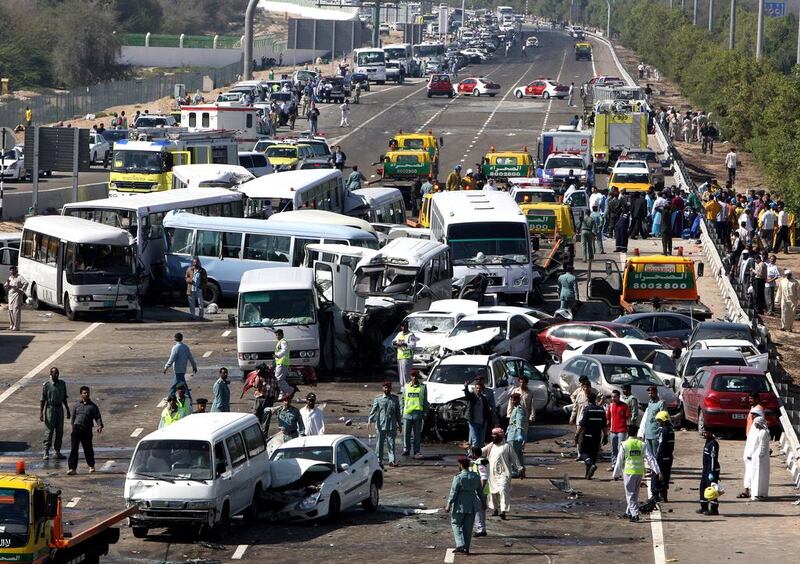ABU DHABI // Fog lights should be mandatory for all vehicles to reduce the risk of road crashes and the severity of injuries from them.
But driver education and enforcement of laws were also crucial, experts said.
“We live in a foggy environment and at certain times of the year, fog is a very real challenge to driving,” said Simon Labbett, regional director of the Transport Research Laboratory, a company helping to develop Abu Dhabi’s road-safety strategy.
“I would be surprised if many motorists didn’t know it gets foggy but it is evident that many do not know how to drive in fog.”
It has been six years since heavy fog on the morning of March 11, 2008, led to a pile-up of more than 200 vehicles on the Abu Dhabi-Dubai motorway near Ghantoot.
Four people were killed, 350 injured and 20 cars caught fire in a mass of tangled wreckage on Fog Tuesday.
Despite lessons learnt from the event, 14 people were injured in a 57-car pile-up on the motorway between Abu Dhabi and Al Ain on January 16 this year.
And about 80 cars were involved in a series of early-morning pile-ups on January 24 as dense fog blanketed both sides of the Abu Dhabi to Dubai road.
Last year the Ministry of Interior and the Emirates Standardisation and Metrology Authority (Esma) started work on making fog lights mandatory.
Brig Gen Ghaith Al Zaabi, director general of traffic coordination at the ministry, last week said the plans had not been scrapped.
“Standards of vehicles being imported need to reflect the local conditions and not the country from which they are sourced,” Mr Labbett said.
“European vehicles imported should have fog lights as a standard feature. This, however, is not the case of many vehicles imported from North America.”
Rear lights make vehicles much easier to be seen when it is foggy but must be switched off at other times, he said.
“Due to the brightness of the lights they must be switched off when it is not foggy,” Mr Labbett said. “Legislation needs to include the inappropriate use and be fully supported by rigorous enforcement.”
Any technology that improves visibility for motorists and provides earlier warning signs for drivers is welcome, said Khaled Al Mansoori, vice chief executive at Emirates Driving Company, the driving school in Abu Dhabi.
“This technology should be mandated for new vehicles, including buses and heavy vehicles,” Mr Al Mansoori said.
“Ideally, fog lights, if mandated for new vehicles, should be activated automatically by sensors, eliminating the need for the driver to remember to activate them.”
Glenn Havinoviski, a transport expert in Abu Dhabi, said drivers understood how front fog lights worked, but not the rear one, which is often built into the left tail light.
All drivers should familiarise themselves with all controls, especially if they are driving a vehicle that is unfamiliar to them, said Dino Kalivas, director of training at the driving school.
“At EDC, theory curriculum and practical classes cover the correct use of vehicle controls including visual diagrams and the correct application of hazard lights, low and high headlight beam and use of indicators,” Mr Kalivas said.
Hazard lights should not be used in moving vehicles. “They are designed to be used when the vehicle is stationary, indicating the road ahead is blocked,” he said.
Mr Labbett stressed the need for driver education and law enforcement.
“It would be useful to provide campaigns informing drivers of the dangers of fog and what to do, and linking this to their legal responsibilities,” he said.
“Ideally, this should be backed up by targeted enforcement to encourage those who have not yet understood or chosen to ignore the advice.”
Appropriate driver behaviour is the key element, said Thomas Edelmann, founder of the website Road Safety UAE.
“Proper fog lights do not replace the non-negotiable reduction in speed and the need of top alertness levels, as well as more distance to the vehicle in front,” he said.
The trend is for improved real-time electronic message signs and electronic variable speed limit signs in areas with frequent congestion, accidents and situations such as fog, Mr Havinoviski said.
“These should establish that the speeds should be lower ahead of the fog condition and that the lower limit, even if temporary, should be enforceable during fog conditions,” he said.
Mr Labbett said the use of variable speed limits in times of reduced visibility has been effective in reducing danger in other countries.
“However, warning messages need to be able to respond to the density quickly and effectively,” he said.
“The best detector of fog is the driver, who needs to take full responsibility and accountability for their actions, their safety and the safety of others.”
rruiz@thenational.ae






